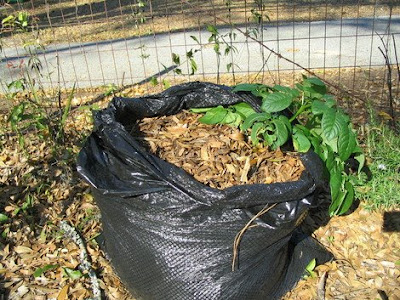Because our front and back yards are heavily shaded with trees, it creates quite a challenge. I figured I would have to dig up the middle of my back yard as it is the only sunny spot...except, this is where the kids play so I was feeling a bit guilty. So, when I found this article about growing potatoes in plastic bags I was thrilled. It would allow me to take advantage of the narrow sunny spots available in my yard and move them if necessary.

My only concern was the plastic and how heating plastic allows chemicals to leach into soil. I might try to track down burlap bags and if needed, set the burlap bag inside a plastic bag...but maybe I am worrrying about nothing??
Check out the article and attached link as it is very interesting.
Living in the city, it can be hard to find a place in your garden for potatoes. Potatoes, grown conventionally, take up a lot of growing space and are time-intensive when it's time to dig them up. There are benefits to growing your own potatoes though. You have a much wider selection than that which you get in the grocery store. You will also have a ready supply of baby new potatoes, considered an expensive delicacy if you have to purchase them but just another potato in your own garden. There are, however, many different methods to growing potatoes in your small garden that save time, space, and work. I have tried many of these methods but the Garbage Bag method is the easiest and most productive.

To use the Garbage Bag method of growing potatoes, all you need is a sturdy garbage bag, like Glad Force Flex, some compost, shredded leaves and seed potatoes. You can purchase certified seed potatoes from a nursery or use sprouted potatoes from your pantry. Seed potatoes are your best bet as they are certified disease free and come in many varieties and colors, from yellow to pink to purple and blue. Cut larger potatoes into pieces that have two or three eyes each. Let potato pieces sit out to dry overnight.
When you are ready to plant, fill garbage bag four inches deep with compost. Roll down sides of bag until just above the level of the soil. Poke holes with the point of a pair of scissors around the exterior of the bag just below the soil line. Site the bag where it will get at least 6 hours of full sun every day. It can be by a fence, on your balcony, or in a sunny unused area of your yard. Plant three seed potato chunks into the soil and cover shallowly. Water lightly. The black garbage bag will provide extra warmth to the potatoes in the spring and fall and they will grow faster than if they were in the ground.
cont'd here






